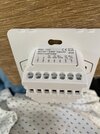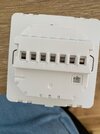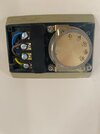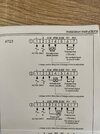I know simply ther live wire being brown will go to L and Blue wire from the honeywell will go to the Tuya N (neutral) point. However i am confused where to connect the ground wiring for the tuya thermostat. Safety's most important i assume in electronics/electrical. Help please thank you!
You are using an out of date browser. It may not display this or other websites correctly.
You should upgrade or use an alternative browser.
You should upgrade or use an alternative browser.
Help! Tuya thermostat wiring for a combi gas boiler - changing from honeywell thermostat to Tuya Thermostat 723 - photos attached
- Thread starter okiedokie
- Start date
-
- Tags
- honeywell thermostat tuya
Sponsored Links
- Joined
- 27 Jan 2008
- Messages
- 25,032
- Reaction score
- 2,901
- Location
- Llanfair Caereinion, Nr Welshpool
- Country

You would need to run a new 4 core cable to replace the 3 core, and the rules say
which since there is no terminal to terminate the earth to, is a bit of a problem, I suppose if a metal back-box then that will have a terminal? The original installer should be taken to court and made an example of, however the courts would be overwhelmed with plumbers.A circuit protective conductor shall be run to and terminated at each point in wiring and at each accessory except a lampholder having no exposed-conductive-parts and suspended from such a point.
Now this Tuya thermostat has already caused confusion...
Terminal 3 on the Tuya might be labeled COM, but it is also labelled (N) - it is a Neutral out to power actuators.
The terminals to use are the potential-free contacts 6 and 7.

Be careful here Eric, that would cause a big bang!, I would also be very naughty and wrap it in brown tape or sleeve and put it in terminal 4 and link 1 and 3
Terminal 3 on the Tuya might be labeled COM, but it is also labelled (N) - it is a Neutral out to power actuators.
The terminals to use are the potential-free contacts 6 and 7.
Do you have a wiring diagram on the rear of the Honeywell cover - something like?...However i am confused where to connect the ground wiring for the tuya thermostat.
- Joined
- 27 Jan 2008
- Messages
- 25,032
- Reaction score
- 2,901
- Location
- Llanfair Caereinion, Nr Welshpool
- Country

Thank-you, I had not realised this, I had just used the picture shown. cymru am bythBe careful here Eric, that would cause a big bang!
Terminal 3 on the Tuya might be labeled COM, but it is also labelled (N) - it is a Neutral out to power actuators.
The terminals to use are the potential-free contacts 6 and 7.
Sponsored Links
It's not easy keeping track of the different versions - this one is designed to operate with UFH actuators, although they are often bought unknowingly for conventional systems.Thank-you, I had not realised this, I had just used the picture shown. cymru am byth
- Joined
- 27 Jan 2008
- Messages
- 25,032
- Reaction score
- 2,901
- Location
- Llanfair Caereinion, Nr Welshpool
- Country

I seem to remember seeing three versions, and as @RandomGrinch says, they had different aims, and the timescale is important, I expect my oil fired central heating to heat a room from eco (17ºC) to comfort (20ºC) within an hour, but with under floor heating (UFH) it may take 4 hours.
So there is no one thermostat suits all.
So there is no one thermostat suits all.
It would be helpful if we could see the internal wiring of the thermostat (I am struggling to find one for any Tuya stat!)Be careful here Eric, that would cause a big bang!
Terminal 3 on the Tuya might be labeled COM, but it is also labelled (N) - it is a Neutral out to power actuators.
The terminals to use are the potential-free contacts 6 and 7.
Doesn't COM (terminal 3) just connect to OPEN (terminal 4) or CLOSE (terminal 5) depending on if there is a call for heat? So though its labelled "(N)" is there an internal connection to N (terminal 2)? If not then could you not just connect L to COM (and jumper to L (terminal 1) as suggested by Eric) and then output L when heat is called for (this would suit me as my motorised valve and then boiler require 230V live not neutral from the thermostat).
- Joined
- 5 Nov 2024
- Messages
- 165
- Reaction score
- 62
- Country

Hijacking one thread is one thing but two gets all confusing with potentially multiple answers. Best starting a new one and link to theseIt would be helpful if we could see the internal wiring of the thermostat (I am struggling to find one for any Tuya stat!)
Doesn't COM (terminal 3) just connect to OPEN (terminal 4) or CLOSE (terminal 5) depending on if there is a call for heat? So though its labelled "(N)" is there an internal connection to N (terminal 2)? If not then could you not just connect L to COM (and jumper to L (terminal 1) as suggested by Eric) and then output L when heat is called for (this would suit me as my motorised valve and then boiler require 230V live not neutral from the thermostat).
This specific model is designed for straightforward connection to UFH systems; not to the motorised valves of a standard wet C/H system.Doesn't COM (terminal 3) just connect to OPEN (terminal 4) or CLOSE (terminal 5) depending on if there is a call for heat? So though its labelled "(N)" is there an internal connection to N (terminal 2)? If not then could you not just connect L to COM (and jumper to L (terminal 1) as suggested by Eric)
On thermostats with volt free switching, it is usual to have COM, NO and NC terminals. In this case the terminal is labelled (N) COM; it is confusing, but still electrically correct to have a common line, or common neutral connection.
The circuit diagrams in the instruction sheet wouldn't work if this had volt free switching - they can only work if the COM is connected to neutral.
Edit:
The confusion may have been noticed.
I've just found these clearer instructions from an updated manual...
And to completely Wrap it up, here is a photo of a Tuya PCB, that I posted on another thread, showing the common Neutrals connected on the PCB...
Last edited:
DIYnot Local
Staff member
If you need to find a tradesperson to get your job done, please try our local search below, or if you are doing it yourself you can find suppliers local to you.
Select the supplier or trade you require, enter your location to begin your search.
Please select a service and enter a location to continue...
Are you a trade or supplier? You can create your listing free at DIYnot Local
Sponsored Links
Similar threads
- Replies
- 9
- Views
- 6K
- Replies
- 4
- Views
- 4K




